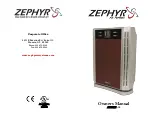
14 Troubleshooting
Installation and operation manual
30
RXYSQ6T7Y1B9
VRV IV-S system air conditioner
4P397285-1B – 2016.03
Main code
Contents
Connection malfunction over indoor units or type
mismatch
Centralised address duplication
Malfunction in communication centralised control
device - indoor unit
Auto address malfunction (inconsistency)
14.2
Symptoms that are not air
conditioner troubles
Following symptoms are not air conditioner troubles:
14.2.1
Symptom: The system does not operate
▪ The air conditioner does not start immediately after the ON/OFF
button on the user interface is pressed. If the operation lamp
lights, the system is in normal condition. To prevent overloading of
the compressor motor, the air conditioner starts 5 minutes after it
is turned ON again in case it was turned OFF just before. The
same starting delay occurs after the operation mode selector
button was used.
▪ If "Under Centralized Control" is displayed on the user interface,
pressing the operation button causes the display to blink for a few
seconds. The blinking display indicates that the user interface
cannot be used.
▪ The system does not start immediately after the power supply is
turned on. Wait one minute until the micro computer is prepared
for operation.
14.2.2
Symptom: Cool/Heat cannot be changed
over
▪ When the display shows
(change-over under centralized
control), it shows that this is a slave user interface.
▪ When the cool/heat changeover remote control switch is installed
and the display shows
(change-over under centralized
control), this is because cool/heat changeover is controlled by the
cool/ heat changeover remote control switch. Ask your dealer
where the remote control switch is installed.
14.2.3
Symptom: Fan operation is possible, but
cooling and heating do not work
Immediately after the power is turned on. The micro computer is
getting ready to operate and is performing a communication check
with all indoor units. Please wait 12 minutes (max.) till this process is
finished.
14.2.4
Symptom: The fan strength does not
correspond to the setting
The fan speed does not change even if the fan speed adjustment
button in pressed. During heating operation, when the room
temperature reaches the set temperature, the outdoor unit goes off
and the indoor unit changes to whisper fan speed. This is to prevent
cold air blowing directly on occupants of the room. The fan speed
will not change even when another indoor unit is in heating
operation, if the button is pressed.
14.2.5
Symptom: The fan direction does not
correspond to the setting
The fan direction does not correspond with the user interface
display. The fan direction does not swing. This is because the unit is
being controlled by the micro computer.
14.2.6
Symptom: White mist comes out of a unit
(Indoor unit)
▪ When humidity is high during cooling operation. If the interior of an
indoor unit is extremely contaminated, the temperature distribution
inside a room becomes uneven. It is necessary to clean the
interior of the indoor unit. Ask your dealer for details on cleaning
the unit. This operation requires a qualified service person.
▪ Immediately after the cooling operation stops and if the room
temperature and humidity are low. This is because warm
refrigerant gas flows back into the indoor unit and generates
steam.
14.2.7
Symptom: White mist comes out of a unit
(Indoor unit, outdoor unit)
When the system is changed over to heating operation after defrost
operation. Moisture generated by defrost becomes steam and is
exhausted.
14.2.8
Symptom: The user interface display
reads "U4" or "U5" and stops, but then
restarts after a few minutes
This is because the user interface is intercepting noise from electric
appliances other than the air conditioner. The noise prevents
communication between the units, causing them to stop. Operation
automatically restarts when the noise ceases.
14.2.9
Symptom: Noise of air conditioners
(Indoor unit)
▪ A "zeen" sound is heard immediately after the power supply is
turned on. The electronic expansion valve inside an indoor unit
starts working and makes the noise. Its volume will reduce in
about one minute.
▪ A continuous low "shah" sound is heard when the system is in
cooling operation or at a stop. When the drain pump (optional
accessories) is in operation, this noise is heard.
▪ A "pishi-pishi" squeaking sound is heard when the system stops
after heating operation. Expansion and contraction of plastic parts
caused by temperature change make this noise.
▪ A low "sah", "choro-choro" sound is heard while the indoor unit is
stopped. When another indoor unit is in operation, this noise is
heard. In order to prevent oil and refrigerant from remaining in the
system, a small amount of refrigerant is kept flowing.
14.2.10 Symptom: Noise of air conditioners
(Indoor unit, outdoor unit)
▪ A continuous low hissing sound is heard when the system is in
cooling or defrost operation. This is the sound of refrigerant gas
flowing through both indoor and outdoor units.
▪ A hissing sound which is heard at the start or immediately after
stopping operation or defrost operation. This is the noise of
refrigerant caused by flow stop or flow change.
14.2.11 Symptom: Noise of air conditioners
(Outdoor unit)
When the tone of operating noise changes. This noise is caused by
the change of frequency.
14.2.12 Symptom: Dust comes out of the unit
When the unit is used for the first time in a long time. This is
because dust has gotten into the unit.



































